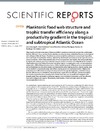Identificador persistente para citar o vincular este elemento:
https://accedacris.ulpgc.es/jspui/handle/10553/58381
| Campo DC | Valor | idioma |
|---|---|---|
| dc.contributor.author | Armengol, Laia | en_US |
| dc.contributor.author | Calbet, Albert | en_US |
| dc.contributor.author | Franchy, Gara | en_US |
| dc.contributor.author | Rodriguez-Santos, Adriana | en_US |
| dc.contributor.author | Hernandez-Leon, Santiago | en_US |
| dc.date.accessioned | 2019-12-13T08:58:33Z | - |
| dc.date.available | 2019-12-13T08:58:33Z | - |
| dc.date.issued | 2019 | en_US |
| dc.identifier.issn | 2045-2322 | en_US |
| dc.identifier.other | WoS | - |
| dc.identifier.uri | https://accedacris.ulpgc.es/handle/10553/58381 | - |
| dc.description.abstract | Oligotrophic and productive areas of the ocean differ in plankton community composition and biomass transfer efficiency. Here, we describe the plankton community along a latitudinal transect in the tropical and subtropical Atlantic Ocean. Prochlorococcus dominated the autotrophic community at the surface and mixed layer of oligotrophic stations, replaced by phototrophic picoeukaryotes and Synechococcus in productive waters. Depth-integrated biomass of microzooplankton was higher than mesozooplankton at oligotrophic stations, showing similar biomasses in productive waters. Dinoflagellates dominated in oligotrophic waters but ciliates dominated upwelling regions. In oligotrophic areas, microzooplankton consumed ca. 80% of the production, but ca. 66% in upwelling zones. Differences in microzooplankton and phytoplankton communities explain microzooplankton diel feeding rhythms: higher grazing rates during daylight in oligotrophic areas and diffuse grazing patterns in productive waters. Oligotrophic areas were more efficient at recycling and using nutrients through phytoplankton, while the energy transfer efficiency from nutrients to mesozooplankton appeared more efficient in productive waters. Our results support the classic paradigm of a shorter food web, and more efficient energy transfer towards upper food web levels in productive regions, but a microbially dominated, and very efficient, food web in oligotrophic regions. Remarkably, both models of food web exist under very high microzooplankton herbivory. | en_US |
| dc.language | eng | en_US |
| dc.relation | "Migradores y Flujo Activo en El Océano Atlántico" | en_US |
| dc.relation.ispartof | Scientific Reports | en_US |
| dc.source | Scientific Reports [ISSN 2045-2322], v. 9, 2044 | en_US |
| dc.subject | 251001 Oceanografía biológica | en_US |
| dc.subject.other | Phytoplankton Growth | en_US |
| dc.subject.other | Community Structure | en_US |
| dc.subject.other | Microbial Control | en_US |
| dc.subject.other | Size-Structure | en_US |
| dc.subject.other | Rates | en_US |
| dc.subject.other | Dynamics | en_US |
| dc.subject.other | Microzooplankton | en_US |
| dc.subject.other | Bacterioplankton | en_US |
| dc.subject.other | Prochlorococcus | en_US |
| dc.subject.other | Synechococcus | en_US |
| dc.title | Planktonic food web structure and trophic transfer efficiency along a productivity gradient in the tropical and subtropical Atlantic Ocean | en_US |
| dc.type | info:eu-repo/semantics/Article | en_US |
| dc.type | Article | en_US |
| dc.identifier.doi | 10.1038/s41598-019-38507-9 | |
| dc.identifier.scopus | 85061574764 | |
| dc.identifier.isi | 000458619600044 | - |
| dc.contributor.authorscopusid | 57194333508 | |
| dc.contributor.authorscopusid | 7003400774 | |
| dc.contributor.authorscopusid | 36650603900 | |
| dc.contributor.authorscopusid | 57203787266 | |
| dc.contributor.authorscopusid | 6701465678 | |
| dc.relation.volume | 9 | - |
| dc.investigacion | Ciencias | en_US |
| dc.type2 | Artículo | en_US |
| dc.contributor.daisngid | 19121052 | |
| dc.contributor.daisngid | 352825 | |
| dc.contributor.daisngid | 11328386 | |
| dc.contributor.daisngid | 29595517 | |
| dc.contributor.daisngid | 489706 | |
| dc.contributor.wosstandard | WOS:Armengol, L | |
| dc.contributor.wosstandard | WOS:Calbet, A | |
| dc.contributor.wosstandard | WOS:Franchy, G | |
| dc.contributor.wosstandard | WOS:Rodriguez-Santos, A | |
| dc.contributor.wosstandard | WOS:Hernandez-Leon, S | |
| dc.date.coverdate | Febrero 2019 | |
| dc.identifier.ulpgc | Sí | es |
| dc.description.sjr | 1,341 | |
| dc.description.jcr | 3,998 | |
| dc.description.sjrq | Q1 | |
| dc.description.jcrq | Q1 | |
| dc.description.scie | SCIE | |
| item.grantfulltext | open | - |
| item.fulltext | Con texto completo | - |
| crisitem.project.principalinvestigator | Hernández León, Santiago Manuel | - |
| crisitem.author.dept | GIR IOCAG: Oceanografía Biológica y Cambio Global | - |
| crisitem.author.dept | IU de Oceanografía y Cambio Global | - |
| crisitem.author.dept | GIR IOCAG: Oceanografía Biológica y Cambio Global | - |
| crisitem.author.dept | IU de Oceanografía y Cambio Global | - |
| crisitem.author.dept | Departamento de Biología | - |
| crisitem.author.orcid | 0000-0002-0479-5571 | - |
| crisitem.author.orcid | 0000-0002-3085-4969 | - |
| crisitem.author.parentorg | IU de Oceanografía y Cambio Global | - |
| crisitem.author.parentorg | IU de Oceanografía y Cambio Global | - |
| crisitem.author.fullName | Armengol Bové,Laia | - |
| crisitem.author.fullName | Hernández León, Santiago Manuel | - |
| Colección: | Artículos | |
Citas SCOPUSTM
91
actualizado el 08-jun-2025
Citas de WEB OF SCIENCETM
Citations
87
actualizado el 08-jun-2025
Visitas
135
actualizado el 07-sep-2024
Descargas
142
actualizado el 07-sep-2024
Google ScholarTM
Verifica
Altmetric
Comparte
Exporta metadatos
Los elementos en ULPGC accedaCRIS están protegidos por derechos de autor con todos los derechos reservados, a menos que se indique lo contrario.
